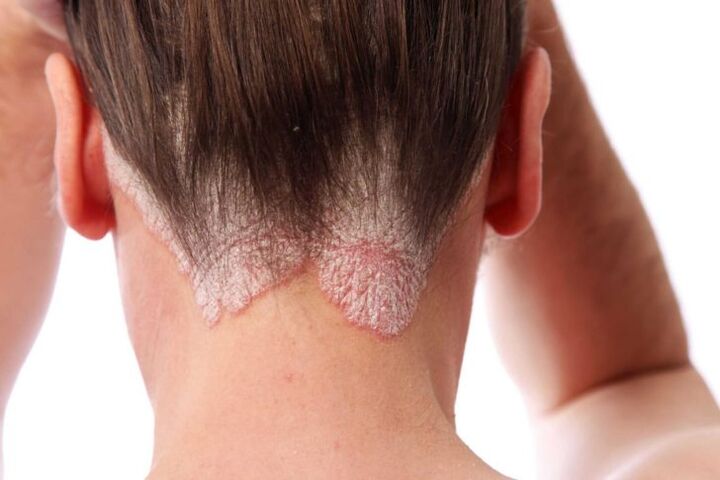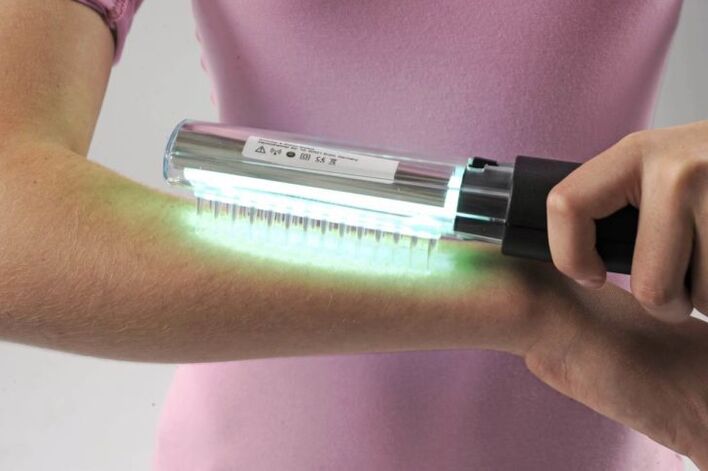Psoriasis is a disease of non -infectious origin, characterized by damage to the skin in the form of their dry raised crusts. Such a crust is an inflamed area formed as a result of increased activity of white blood cells - lymphocytes and excessive formation of small capillaries in the surface skin layer.
Psoriasis - what is it

To date, the true causes of the disease have not been established. It is known that in most cases it has a hereditary character, that is, it is transferred to children from parents. At the same time, a person suffering from this ailment does not pose any threat to the health of others, since special plaques formed on the skin are not infectious.
Some experts are inclined to believe that the development of the disease largely depends on the state of the human immune system, since, in fact, psoriasis is nothing more than an accumulation of a huge number of lymphocytes, blood cells that are directly related to the protective function of the body. It is they who give the cover in places of defeat white.
Psoriasis can appear on any part of the body, even under the hair of the head. However, the skin most often suffers from the disease, constantly subjected to friction: on elbows, knees, between the buttocks.
The disease can occur in a completely healthy, never previously collided person after the transfer of severe stress. Its cause can also be small lesions as a result of accidental injury or burn. Dry cold weather can provoke the development of the disease in people predisposed to it. The ailment, which manifested itself in early childhood, can completely pass on its own as the child grows up.
Localization zones
Rashes for psoriasis can be localized in completely different places. In addition to the usual location on the body and in the skin of the skin, the following can be distinguished:
- Face - rashes are rare, more often these are single papules near the eyes and nose.
- The lips are rarely affected, but such localization is not excluded. The rashes are very itchy, accompanied by redness and pronounced discomfort.
- The scalp is affected by each second patient. Most often proceeds in the form of seborrhea.
- Palms and soles - foci especially occurs in places of contact with cuffs or elastic bands from socks. With the progression of peeling, they are noted between the fingers and legs.
- The ear is affected more often simultaneously with the involvement of the scalp, when the foci grows on the auricle.
- Male and female genital organs can also be involved in pathology. This is explained by constant humidity, favorable for psoriasis. It is localized in the groin, on the external genitalia, less often on the inner part of the foreskin in men. In women, single rashes are possible on the labia.
Stages of development
In the development of psoriasis, three stages can be easily noticed:
- Progressive - the beginning of pathology, more often with a bright clinic, the rash quickly spreads through the body, large foci formed.
- Inpatient - at this stage there is no fresh rashes, but the old ones do not change their shape at the same time.
- Regression - peeling gradually decreases, and the process from the center begins, as a result of which the rings and figures of irregular shape appear.
The course of the pathology does not end there. The pathology proceeds in a circle, replacing all three stages. Therefore, after regression, it is especially important to pay attention to prevention.
Symptoms and signs of the disease, manifested on the skin of the body and head
Currently, more than six types of psoriasis are known, each of which has its own symptoms. Symptoms common to all forms of the disease include: a feeling of tightness of the skin and severe itching.
Simple or other psoriasis among residents of Russia is most common. Its main symptoms include:
- Formation in places of inflammation of raised skin plaques;
- Thickening of the skin, excessive dryness and peeling;
- Bleeding;
- The rapid spread of the disease over the body of the body.
In the reverse form, there is:
- The appearance of smooth, slightly raised above the skin, red inflamed spots in the places of bends of the arms and legs, in the groin and other skin folds;
- Joining a secondary infection as a result of injury inflamed skin with a cloth of clothing and then;
Genital psoriasis makes itself felt by the appearance of a large number of small fragmented elements of inflammation in the form of drops and points. The color of such formations can vary up to purple. A similar form of the disease is often manifested in the back of the back, hips and shoulders. Exacerbation of a rocking shape is usually observed after the transfer of any infection.
The most severe form of the disease includes pustular psoriasis. Its main symptoms:
- The appearance of bubbles filled with liquid on the skin of various sizes;
- Inflammation and gradual peeling of the skin located under them;
- Gradual fusion of bubbles into one large formation, fluid;
- The introduction of a secondary infection with the filling of skin bubbles with purulent contents.
Most often, this form is localized in the legs, arms, forearms. A separate form of the disease is considered to be nail psoriasis, which does not spread beyond the nail. It is possible to establish its presence by the appearance on the nails of lines, spots and dots of various sizes, a change in the color of the nails, thickening the skin around and under them, easy peeling of the nail plate. Usually, the psoriasis of the nails ends with their complete loss.

A complication of the disease is psoriatic arthritis - the spread of inflammation of the skin to previously healthy joints. The disease is characterized by strong swelling of the joints, regardless of their location, often leads to disability.
Features of the course of women and men
There are no special clinical differences during psoriasis for men and women. In each individual case, severity and localization depend on individual characteristics. The only thing that can be noted is that in men, rashes are often localized on the inside of the thigh in the groin. In women, peeling can form under the mammary glands. This is especially characteristic of the menopausal period when the disease is aggravated as a result of hormonal changes.
Treatment
The therapy of pathology should be complex and is given almost constantly, which will not allow the formation of new foci. If you take a review of funds from psoriasis, the following forms and methods can be distinguished:
- Creams from psoriasis. The most effective funds will be the basis of which includes solidol. Hormonal ointments are also used. The target compositions also found application.
- Pills. General treatment is also important to achieve the result.
- Vitamins. They are required during the treatment of pathology. They are selected only individually, since each patient can have its own reaction to the element.
- Shampoos. Funds based on tar and coal resin are shown.
- Patch. More often these are Chinese products with a natural composition. Quannaide Xinmeisu Tiegao and delicate skin are particularly popular.
- Therapeutic baths. Salt baths showed a high effect. Sea salt with a high content of minerals is used. Suitable for home use. For some patients, turpentine baths and herbs help.
- Lamp. Phototherapy has long proved its effectiveness. There are devices for both inpatient use and for the home. Regular sessions allow remission for 3-4 months. In practice, lamps such as ultraviolet 311 nm, selective phototherapy, and bullet therapy are used.
- Starvation. The method is unusual, but effective. Allows you to achieve remission, but has a large number of contraindications.
- Plasmapheresis. Allows you to clear the blood and reduce the likelihood of exacerbation.
Some recommendations (is it possible in the bathhouse, solarium, etc. )
Psoriasis imposes some restrictions on the patient's life. Separately, you should figure out whether it is possible to visit a sauna and a bath with such a disease. In general, such procedures are very useful. They allow:
- Saturate cells with oxygen.
- Derive toxins and slag.
- Increase skin sensitivity to local drugs.
- Improve the general psycho -emotional state.
Thus, with psoriasis, visiting the bath will also be appropriate, but it is important to carefully comply with all the rules for visiting the steam room.
Another important issue is to visit the solarium. It is much more complicated above. The fact is that each device has a concentration of UV rays. The optimal wavelength is 300-400 nm. At the same time, the presence of the reflector increases the radiation force by 10%. Therefore, if the device is suitable for the described parameters and there is no reflector, visiting the solarium within reasonable limits will give a positive effect.
It will be useful to figure out hair dyeing. When involving the hairy part of the head from complete coloring, it is better to refrain. The highlighting or coloring will be acceptable. If there is gray hair and hair dyeing is a necessary procedure, you should especially carefully approach the choice of paint, give preference to quality products.
Features of sexual activity in psoriasis
Talking about whether there is a peculiarity of sexual life in psoriasis, it is worth recalling that this disease is not tolerated. Do not be afraid of such people. All complexity lies only in a complex, which is often observed in such patients. Therefore, it is important to find a person who can be trusted and talk about the disease, being confident in an adequate reaction. In general, psoriasis does not affect sexual life in any way. If the rashes are available on the genitals, they should be treated so as not to provoke a secondary infection.
Whether it is inherited

Regarding the hereditary predisposition of psoriasis, there was a lot of disputes. It cannot be argued that the child will definitely have a disease. Yes, it has a predisposition, but subject to prevention measures, you can avoid the development of pathology in the active phase.
It is noted that psoriasis can manifest itself even after a few generations among great -grandchildren.
Whether they take the army with psoriasis
The presence of psoriasis in the history of the release from military duty can cause to receive exemption. If earlier the guy was registered with this pathology, you should provide documents confirming the presence of psoriasis. In this case, the size and number of foci is important:
- Category B is the presence of three or more foci with different localization.
- Category B - single foci of large sizes (more than 10x15 cm).
Each case is considered individually with the determination of the severity of the current.
Prevention
Given the fact that the pathology proceeds according to phases, it is important to pay attention to prevention after regression. First of all, this is a diet. It implies the exclusion of fatty, fried dishes and spices. The diet should be diversified by vegetables, fish and cereals. In the spring-autumn period, it is important for vitamin therapy.
The doctor can choose preventive procedures. With psoriasis, plasmapheresis and UOFO have proven itself perfectly.
Attentive attitude to your health, strengthening the body's protective functions, hardening, positive life mood usually avoiding the manifestations of a chronic disease over a long period of time.























